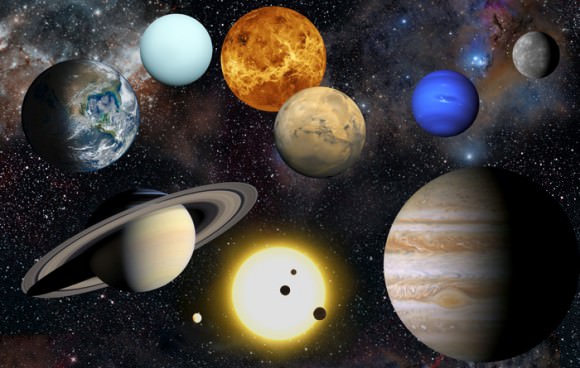
Mercury: Overview: The Swiftest Planet
Mercury's surface temperatures range from 467 degrees Celsius (872 degrees Fahrenheit) to -183 degrees Celsius (-300 degrees Fahrenheit).
Mars’ average surface temperature is -55 °C, but the Red Planet also experiences some variability, with temperatures ranging as high as 20 °C at the equator during midday, to as low as -153 °C at the poles. On average though, it is much colder than Earth, being just on the outer edge of the habitable zone, and because of its thin atmosphere – which is not sufficient to retain heat.
In addition, its surface temperature can vary by as much as 20 °C due to Mars’ eccentric orbit around the Sun (meaning that it is closer to the Sun at certain points in its orbit than at others).
What is the Average Surface Temperature of the Planets in our Solar System?
It’s is no secret that Earth is the only inhabited planet in our Solar System. All the planets besides Earth lack a breathable atmosphere for terrestrial beings, but also, many of them are too hot or too cold to sustain life. A “habitable zone” which exists within every system of planets orbiting a star. Those planets that are too close to their sun are molten and toxic, while those that are too far outside it are icy and frozen.
But at the same time, forces other than position relative to our Sun can affect surface temperatures. For example, some planets are tidally locked, which means that they have one of their sides constantly facing towards the Sun. Others are warmed by internal geological forces and achieve some warmth that does not depend on exposure to the Sun’s rays. So just how hot and cold are the worlds in our Solar System? What exactly are the surface temperatures on these rocky worlds and gas giants that make them inhospitable to life as we know
But at the same time, forces other than position relative to our Sun can affect surface temperatures. For example, some planets are tidally locked, which means that they have one of their sides constantly facing towards the Sun. Others are warmed by internal geological forces and achieve some warmth that does not depend on exposure to the Sun’s rays. So just how hot and cold are the worlds in our Solar System? What exactly are the surface temperatures on these rocky worlds and gas giants that make them inhospitable to life as we know
Of our eight planets, Mercury is closest to the Sun. As such, one would expect it to experience the hottest temperatures in our Solar System. However, since Mercury also has no atmosphere and it also spins very slowly compared to the other planets, the surface temperature varies quite widely.
What this means is that the side exposed to the Sun remains exposed for some time, allowing surface temperatures to reach up to a molten 465 °C. Meanwhile, on the dark side, temperatures can drop off to a frigid -184°C. Hence, Mercury varies between extreme heat and extreme cold and is not the hottest planet in our Solar System.
Venus: Overview: Planetary Hot Spot
That honor goes to Venus, the second closest planet to the Sun which also has the highest average surface temperatures – reaching up to 460 °C on a regular basis. This is due in part to Venus’ proximity to the Sun, being just on the inner edge of the habitability zone, but also to Venus’ thick atmosphere, which is composed of heavy clouds of carbon dioxide and sulfur dioxide.
These gases create a strong greenhouse effect which traps a significant portion of the Sun’s heat in the atmosphere and turns the planet surface into a barren, molten landscape. The surface is also marked by extensive volcanoes and lava flows, and rained on by clouds of sulfuric acid. Not a hospitable place by any measure!
Our Home Planet
Mars: Overview: The Red Planet
Minimum/Maximum Surface Temperature
|
-88/58 (min/max) °C
|
-153 to +20 °C
|
Atmospheric Constituents
|
Nitrogen, Oxygen
|
Carbon Dioxide, Nitrogen, Argon
|
Jupiter: Overview: King of the Planets
Since Jupiter is a gas giant, it has no solid surface, so it has no surface temperature. But measurements taken from the top of Jupiter’s clouds indicate a temperature of approximately -145°C. Closer to the center, the planet’s temperature increases due to atmospheric pressure.
At the point where atmospheric pressure is ten times what it is on Earth, the temperature reaches 21°C, what we Earthlings consider a comfortable “room temperature”. At the core of the planet, the temperature is much higher, reaching as much as 35,700°C – hotter than even the surface of the Sun.
Saturn: Overview: Jewel of Our Solar System
Due to its distance from the Sun, Saturn is a rather cold gas giant planet, with an average temperature of -178 °Celsius. But because of Saturn’s tilt, the southern and northern hemispheres are heated differently, causing seasonal temperature variation.
Uranus: Overview: The Sideways Planet
Neptune: Overview: The Windiest Planet
..
..